Overclockers Titan Gladius Review
Overclockers Titan Gladius Review
Our first Kaby Lake PC review

Verdict
Pros
- Smooth 4K gaming
- Exceptional performance
- Beautiful case and build
Cons
- Expensive
- Faster SSDs are available
Key Specifications
- Review Price: £2423.00
- 4.2-4.5GHz Intel Core i7-7700K (overclockable)
- 16GB DDR4 RAM
- 512GB M.2 SSD + 2TB hard disk
- 2x 8GB Nvidia GeForce GTX 1070
- 2x front USB 3.0 ports, 4x rear USB 3.0 ports, 1x USB 3.1 port, 1x USB 3.1 Type C port
- Controllable LEDs
- Three-year warranty (two years collect and return, one year labour)
What is the Overclockers UK Titan Gladius?
If you’re going to use the latest technology in a high-end PC, why hold back? That’s the route that Overclockers has taken with its Titan Gladius desktop PC. Kitted out with an Intel Core i7-7700K Kaby Lake processor, dual Nvidia GeForce GTX 1070 graphics cards and a gorgeous metal and glass case, the Titan Gladius is a desktop PC built for high-quality 4K gaming.
Related: Intel Kaby Lake review
Overclockers UK Titan Gladius – Design and Build
Overclockers has built the Titan Gladius into a Phanteks Enthoo Evolve ATX midi tower case. With its steel frame and tempered-glass sides that let you peer inside, it’s a top case and one of the most attractive that I’ve seen.
The glass sides also mean that you get the full benefit of the Asus Aura system: colour-coordinated LED lights emanating from the motherboard, graphics card and LED strip. Overclockers has set the lights to slowly pulse red, although the Asus Aura utility for Windows lets you control the colour and light pattern.
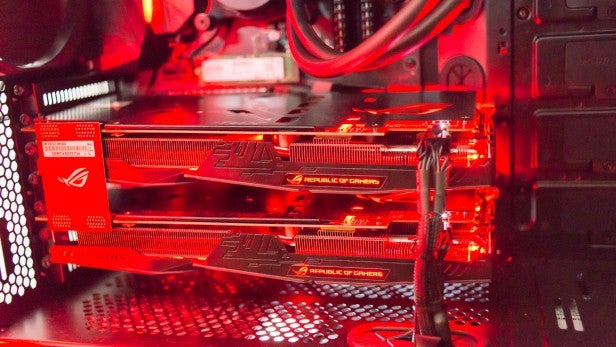
The front of the case is dominated by its plain metal facade, which has a compartment that slides open to reveal the front ports: 2x USB 3.0, headphone out, microphone in and the reset switch. It’s a very neat design that gives the Titan Gladius a sophisticated look, particularly when you don’t have anything plugged into the front.
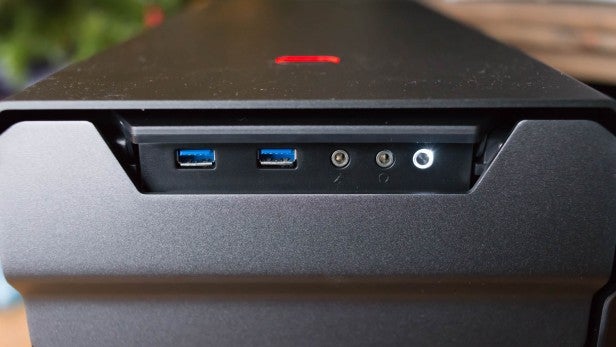
Around the back are all of the ports that you could need. Joining the four USB 3.0 ports are the single USB 3.1 and USB 3.1 Type-C ports. In addition, you get five 3.5mm audio jacks and an optical S/PDIF output. If you’re still using an old PS/2 keyboard or mouse, there’s a single legacy port, too. You don’t need to worry about graphics outputs, as the dual graphics cards provide a total of two DVI, four DisplayPort and four HDMI outputs.
Importantly, the Phanteks Enthoo Evolv ATX is a comparatively compact case, so you get all of the power that you need, squeezed into a small footprint (495 x 240 x 507mm).
Inside the case, space is used efficiently to keep the build clutter-free. At the bottom of the case, the 850W Super Flower Leadex Platinum is housed in a separate compartment, so only the power cables that need to go to the motherboard and graphics card come up into the main compartment.
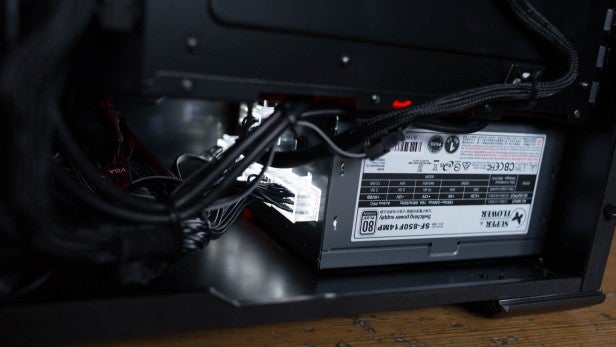
In front of the PSU is a drive bay holding the 2TB WD Black drive, which should provide more than enough storage for the majority of people. Mechanical hard disks can’t provide the performance that I expect from a modern computer, so the main boot drive is a 512GB Samsung SM961 drive. As this drive needs neither power nor cables, it doesn’t add to the clutter of the case. Installed in the motherboard is 16GB of RAM, split between two 8GB sticks of DDR4 RAM. That leaves two memory slots on the Asus ROG Strix Z270F motherboard for future expansion.
Cooling the CPU is an Asetek 570LX liquid cooler. Two heat pipes lead up to the large radiator mounted at the top of the case, with heat dissipated by the dual 120mm fans. A rear-mounted 140mm fan and front-mounted 120mm fan complete the cooling. Although the Titan Gladius isn’t silent, the combination of large fans means it only generates a low-level hum. Impressively, even under heavy load, the PC didn’t get any louder. The PC was set to use the default cooling profile – the UEFI BIOS settings let you select a ‘Silent’ profile if you’d rather dial down the noise a bit further.
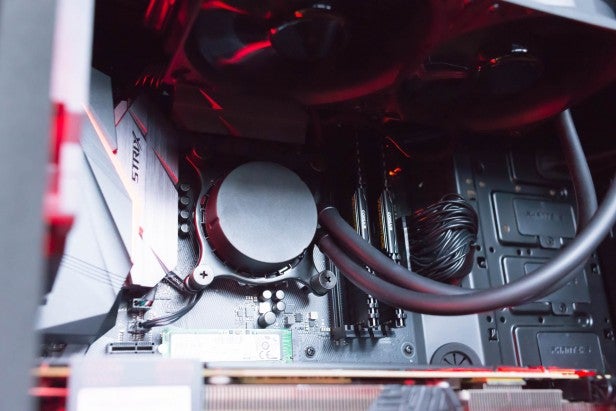
Overclockers hasn’t installed the additional HDD mounts in the case’s main cavity, although they’re included in the box if you need to add any more drives. However, there are spare drive mounts around the back of the case, which you’d be better off using first to keep the main case uncluttered, and the motherboard has a spare M.2 slot for more fast and compact storage.
The removal of the drive bays also gives some room around the dual ASUS GeForce GTX 1070 Strix Gaming graphics cards. For expansion, you’re left with one PCI-E x1 slot at the top, plus one PCI-E x1 slot sandwiched between the two graphics cards and one PCI-E x16 slot (running at x4 speed) at the bottom for expansion. Using the two lower slots would put any expansion card underneath a graphics card’s fan, so I recommend using the top slot and external peripherals.
Overclockers UK Titan Gladius – Performance
Spending this much on a computer demands that you get the performance to match. I’m very happy to say that you will not be disappointed. Overclockers has used the top-of-the-range Intel Core i7-7700K, which usually runs at 4.2GHz, with Turbo Boost taking it to 4.5GHz. For this PC, Overclockers has overclocked the processor to 4.8GHz, setting all cores to have a multiplier of 48. It’s a quad-core chip, although Hyper-Threading adds four more virtual cores.
Combined with the 16GB of DDR4 RAM, this PC scored a massive 19,523 in the Geekbench multicore benchmark and 5,387 in the PC Mark 8 Home test. TrustedReviews’ benchmark tests have shown that the stock 7700K is around 9% faster than the previous-generation 6600K, although the Titan Gladius’ overclock will make it a little faster. It means that AMD has a real chance of taking the performance crown from Intel with its upcoming Ryzen CPU.
The build of the PC and quality of cooling has a part to play, as better cooling means more thermal headroom for Turbo Boost. Compared to the Scan 3XS LG17 Carbon Extreme laptop, which uses a Core i7-6700K, the Titan Gladius was 16-20% faster across the board.
As Overclockers has used a ‘K-series’ chip, the CPU is unlocked, so you can push it faster if you want, beyond even what Overclockers has set. Ultimately, while Kaby Lake might not be that much faster than the previous-generation Skylake, the Titan Gladius is still incredibly fast and capable of handling anything that you can throw at it.
This is really a PC designed for gaming, and it certainly doesn’t disappoint. While the GeForce GTX 1070 is an excellent choice for Full HD and 1440p gaming, Overclockers has used two of them in SLI configuration, making this PC is all about 4K. Each card has 8GB of GDDR5 RAM, with a base GPU clock of 1,632MHz (1,835MHz in OC mode).
Running at a 4K resolution the Titan Gladius managed 78.56fps in Rise of the Tomb Raider, 101.61fps in Dirt Rally and 102.99fps in Middle-earth: Shadow of Mordor. In other words, high-quality, high-resolution gaming is here, and the combined power of two GTX 1070 cards outstrips a single GeForce GTX 1080.
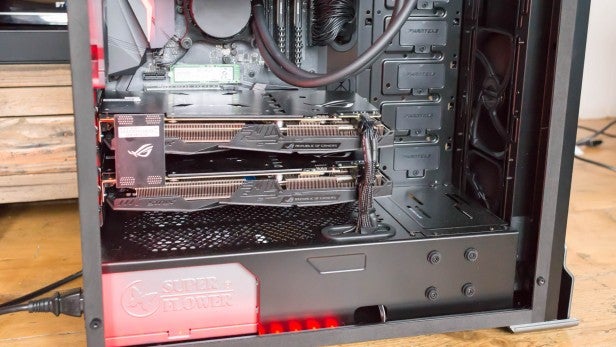
Overclockers has used a 512GB Samsung SM961 nVME SSD fitted into the motherboard’s M.2 slot. This OEM drive has similar performance to the 950 Pro, and I measured read speeds of 1,752MB/s and write speeds of 1,441MB/s. Needless to say, Windows and games load incredibly fast and the PC felt very responsive. However, at this price I would have liked to have seen the newer, faster, Samsung 960 Pro drive.
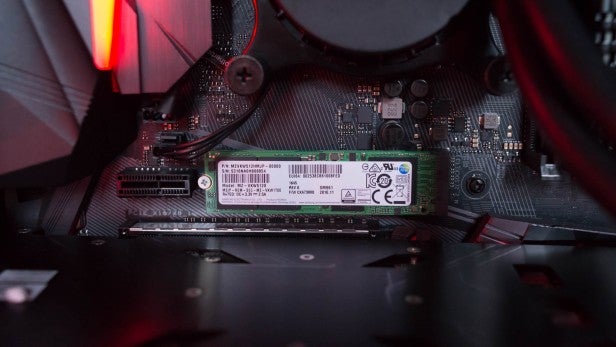
Should I buy the Overclockers UK Titan Gladius?
While Intel’s Kaby Lake architecture has hardly set the performance world alight, the truth is that the 7700K is the fastest consumer processor currently available, making the Overclockers Titan Gladius an extremely fast PC. Combined with its dual Nvidia GeForce GTX 1070 graphics cards, this is a PC that delivers high-quality 4K gaming.
With its neat case and excellent build, it’s also a PC that has the looks to match its brawn. At this price, I’d expect nothing less, and you’re paying a lot of money to get the latest tech and fastest gaming performance – the graphics cards alone would set you back around £850 if you bought them individually. My only minor complaint is that the M.2 SSD is an older-generation SM961 rather than the faster 960 Pro.
Buy now: Titan Gladius from Overclockers.co.uk
Whether or not the Titan Gladius is the right choice for you comes down to what you want from a PC. If you’ve got a 4K display and want to play games smoothly at this resolution, as well as having the fastest consumer processor that you can buy, the Titan Gladius is the answer.
If you don’t have such a high-resolution display, then you can save a considerable amount of money by shopping elsewhere. The Alienware Aurora, for example, costs around half the price, uses last year’s Intel Core i7-6700 CPU, which is around 30% slower than the chip used here, and has a single GeForce GTX 1070 graphics card for fast 1440p gaming.
Related: Best Gaming PC: The ultimate PC building guide
Verdict
A beautifully made PC packed with the latest technology, this computer is expensive, but it delivers super-smooth 4K gaming.
Trusted Score
Score in detail
-
Value 7
-
Features 8
-
Heat & Noise 8
-
Performance 9
-
Design 8


